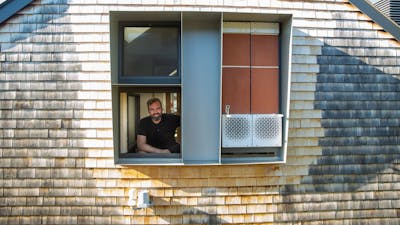The Problem
As average global temperatures steadily climb, the worldwide demand for air conditioning is expected to triple by 2050. Conventional air conditioners, while cheap to manufacture, still rely on inefficient mechanical vapor compression methods developed almost a century ago to cool and dehumidify air, making them one of the largest consumers of energy in industrialized countries. An alternative cooling method called evaporative cooling (EC) uses up to 75% less energy than vapor-compression systems, but EC only works well in relatively dry climates because it adds moisture to the cooled air, making it less effective in humid areas.
Our Solution
cSNAP, our evaporative cooling technology, designed by a multidisciplinary team of scientists and designers from the Wyss Institute, Harvard’s Graduate School of Design (GSD), and the Harvard Center for Green Buildings and Cities (HCGBC) is a durable, low-cost, low-energy EC system that can work efficiently in hot and hot-humid climates, and could one day replace vapor-compression coolers with a much more environmentally friendly option.
Inspired by the water repellency of duck feathers, our evaporative cooling technology consists of 3D-printed ceramic coated with a novel, nanoscale hydrophobic material. The coating effectively isolates water vapor from the air that is released into a building, preventing it from becoming humid while promoting heat transfer to maximize cooling.
cSNAP could be integrated into existing EC coolers and sold as environmentally friendly air conditioning units in a wide variety of climate zones. It could even be manufactured into the façades of buildings, which would allow them to effectively cool the space within while only using energy to pump water through the system.
Product Journey
This technology has been tested in real-world conditions at Harvard’s HouseZero, and showed that it effectively cooled indoor air even in extremely hot conditions.
The team is combining their evaporative cooling system with additional innovations that pre-treat and dehumidify the input air, further maximizing its cooling capability and allowing it to be used in a wide variety of markets and climate zones around the world. The team plans to launch a startup to commercialize their technology, and is seeking inquiries from interested investors and partners.

